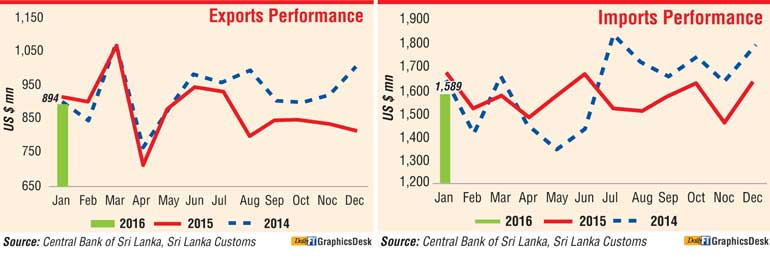Friday Nov 15, 2024
Friday Nov 15, 2024
Monday, 9 May 2016 00:00 - - {{hitsCtrl.values.hits}}
 Sri Lanka’s external sector showed a modest performance during the month of January 2016 with both exports and imports declining and trade deficit contracting.
Sri Lanka’s external sector showed a modest performance during the month of January 2016 with both exports and imports declining and trade deficit contracting.
Earnings from exports declined for the eleventh consecutive month in January 2016 recording a 2.5% decline, year-on-year, to $894 million and expenditure on imports contracted by 5.5%, year-on-year, to $1,589 million. Consequently the deficit in the trade account contracted in January 2016, by 9.1%, on a year-on-year basis, to $695 million compared to $765 million in January 2015. The Central Bank said the trade deficit narrowed on account of the higher decline in import expenditure mainly due to the drop in fuel, vehicle and rice imports, compared to the decline in earnings from exports during January 2016.
Following is the Central Bank’s statement on exports and import performance in January: Earnings from exports declined for the eleventh consecutive month in January 2016 recording a 2.5% decline, year-on-year, to $894 million largely reflecting continuous decline recorded in commodity prices in the international market. Exports of petroleum products, gems, diamonds and jewellery, tea, and spices mainly contributed for this decline. Earnings from petroleum products in January 2016 declined by 53.3%, year-on-year, reflecting a drop in both bunkering quantity and average price level. Exports of gems, diamonds and jewellery showed a significant decline of 33.4% owing to declines recorded in exports of gem and diamond sub categories. The continuous weakening of demand for Ceylon tea from the major tea export destinations mainly Russia, Turkey and some Middle-Eastern countries, caused export earnings from tea to decline by 12.4% in January 2016, year-on-year. Both the export volume and the average price of tea were lower than previous year. Earnings from spices exports, which improved significantly during the year 2015, declined by 26.8% in January 2016, year-on-year, reflecting declines in pepper, cloves and nutmeg exports despite the significant growth recorded in exports of cinnamon. Further, machinery and mechanical appliances, leather, travel goods and footwear and minor agricultural products also contributed to the drop in earnings of exports in January 2016. However, export earnings from textiles and garments, which contributed nearly 52% to the total exports, improved by 13.3% year-on-year in January 2016, reversing the declining trend prevailed in last quarter of 2015. Garment exports to both traditional and non-traditional markets improved during the month. In addition, earnings from rubber products increased by 11.1%, year-on-year, during the month mainly due to the growth in earnings from exports of rubber tires. In addition, earnings from coconut exports showed a significant improvement while earnings from the export of food, beverages and tobacco, animal fodder, and plastics and articles thereof showed a marginal improvement in January 2016. In January 2016, main export destinations were the USA, UK, Germany, India and Italy, accounting for about 53% of the total exports.
Import Performance
Continuing the declining trend prevailed during the last six months, expenditure on imports contracted by 5.5%, year-on-year, to $1,589 million in January 2016. Significant decline recorded in expenditure on fuel imports followed by rice imports and vehicle imports for personal use and investment purposes contributed mainly to this reduction in imports. Import expenditure on fuel declined significantly by 39.6%, year-on-year, to $175 million, due to the drop in average import prices of all categories of fuel together with lower import volume of refined petroleum and coal. Continuing the declining trend prevailed during the previous year, international oil prices dropped further in January 2016, which resulted in decline of the average import price of crude oil to $31.87 per barrel compared to $55.47 per barrel recorded in January 2015. Meanwhile, expenditure on rice imports declined by 98.0% to $1.1 million in January 2016 for the ninth consecutive month in comparison to $55 million in the corresponding month of 2015 due to bumper paddy harvests recorded in 2015. Reflecting the impact of increase in taxes for motor vehicles by the budget for 2016 expenditure on importation of vehicles for personal use and investment purposes which categorised under consumer goods and investment goods declined significantly by 12.6% and 42.3%, respectively, in January 2016. Due to this tax increase, importation of personal motor vehicles, such as motor cars and motor cycles and road vehicles such as lorries, trishaws and buses which are imported specially for investment purposes declined during the month. In addition, expenditure on base metals and sugar and confectionery imports also contributed towards reducing the import expenditure in January 2016. However, in line with the growth recorded in the export earnings from textiles and garments, import expenditure on textile and textile articles increased by 25.4%, in January 2016 owing to the 34.0% increase recorded in fabrics imports. Also reflecting the increases recorded in all sub categories, except iron and steel and insulated wires and cables, expenditure on building materials increased by 23.7%, on a year-on-year in January 2016. Although the 14.6% decline recorded in average import prices, expenditure on wheat and maize imports increased significantly by 102.0%, year-on-year, due to the substantial 136.6% growth recorded in import volumes. Further, import expenditure on diamonds and precious stones and metals, machinery and equipment, and vegetables also increased during the month.
In January 2016, main import origins were China, India, Japan, UAE and South Korea, accounting for about 54% of the total imports.
Trade Balance
The deficit in the trade account contracted in January 2016, by 9.1%, on a year-on-year basis, to $695 million compared to $765 million in January 2015.